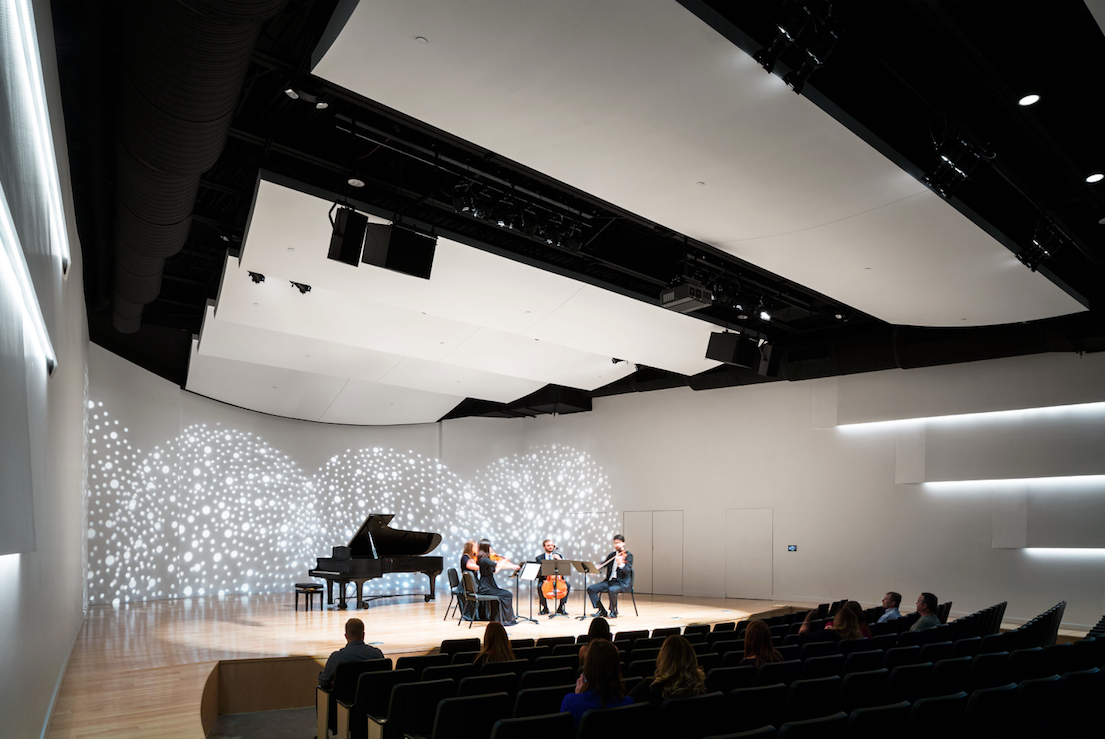A couple of years ago, Ruth Meints, Executive Director of the Omaha Conservatory of Music, got a notice from the organization’s landlord that the conservatory would have to vacate its space in a local community center by January 2016. Meints, who also teaches violin and viola at the OCM, wasn’t crazy about the space to begin with—it was small and had acoustical problems—but it was home. What to do?
Luckily, Meints happened to be in touch with David Lempke, HDR’s Vice President and Design Principal, and Lempke happened to be aware that Temple Israel had built a new facility in town, which freed up its old building as a possible home for the conservatory.
The old temple, built in 1952, was in decent shape, Lempke recalls. The conference room, administrative offices, and classrooms could be reprogrammed relatively easily for the conservatory’s needs for studios and teaching spaces. But the windows and roof needed to be replaced. Many of the walls lacked insulation or vapor barriers. The HVAC system had no humidity control—essential to protect the musical instruments—and would have to be replaced.
After $15 million in reconstruction, the new 40,000-sf conservatory opened in late 2015, well ahead of the deadline. The sanctuary, with its sloping floors and sidewalls, was converted to a shoebox-shaped performance center with a 48-foot-wide stage. Irwin Seating Company installed telescopic seats whose backs and bottoms fold up and retract, bleacher-style, into the back wall. This more than doubled the seating capacity to 500.
These days, Meints can lead her Violin Sprouts - the program she pioneered in 2013 for young musicians - under much improved conditions.
 After a devastating fire, Congregation Kehilath Jeshurum in New York reconsidered how to expand its sanctuary (pictured in its rebuilt state) and its school. Image: Chris Cooper.
After a devastating fire, Congregation Kehilath Jeshurum in New York reconsidered how to expand its sanctuary (pictured in its rebuilt state) and its school. Image: Chris Cooper.
OUT OF THE ASHES
Five years ago, FXFowle Architects was overseeing the renovation of Congregation Kehilath Jeshurun’s synagogue, in the Upper East Side of New York City, when the roof went up in flames. The fire severely damaged the century-old sanctuary but spared the lower school and the limestone neo-Classical façade. The fire prompted the institution to reconsider how to grow its facilities to meet the needs of its congregation and students.
Ann Rolland, FAIA, Principal with FXFowle, says that her firm recommended moving the 1,150-student school and gym to higher floors, which would more clearly delineate the functions of the building along its horizontal and vertical axes. That move required erecting a complicated structural system to support the two-story addition and relieve pressure on the synagogue’s walls during construction.
FXFowle brought the 18,000-sf sanctuary up to code. Italian crafts workers, using traditional methods, recreated columns, egg-and-dart molding, and new scagliola finishes on the main ark and new column enclosures. The steel reinforcement within the sanctuary had to be positioned to minimize seating loss for congregants.
This 80,000-sf project, which was completed in the summer of 2015, came in on budget at $40 million, says Rolland. ZDG LLC was the cost estimator; project management firm VVA was owner’s representative.
The synagogue’s worst fear—that its congregation would drift away during the reconstruction—proved to be unfounded. “This project was about rebuilding and revitalizing a community,” says Rolland.
Related Stories
| Jul 18, 2014
Top Engineering Firms [2014 Giants 300 Report]
Fluor, Arup, Day & Zimmermann top Building Design+Construction's 2014 ranking of the largest engineering firms in the United States.
| Jul 18, 2014
Top Architecture Firms [2014 Giants 300 Report]
Gensler, Perkins+Will, NBBJ top Building Design+Construction's 2014 ranking of the largest architecture firms in the United States.
| Jul 18, 2014
2014 Giants 300 Report
Building Design+Construction magazine's annual ranking the nation's largest architecture, engineering, and construction firms in the U.S.
| Jul 7, 2014
7 emerging design trends in brick buildings
From wild architectural shapes to unique color blends and pattern arrangements, these projects demonstrate the design possibilities of brick.
| Jul 7, 2014
A climate-controlled city is Dubai's newest colossal project
To add to Dubai's already impressive portfolio of world's tallest tower and world's largest natural flower garden, Dubai Holding has plans to build the world's largest climate-controlled city.
| Jul 2, 2014
Emerging trends in commercial flooring
Rectangular tiles, digital graphic applications, the resurgence of terrazzo, and product transparency headline today’s commercial flooring trends.
| Jun 30, 2014
Philip Johnson’s iconic World's Fair 'Tent of Tomorrow' to receive much needed restoration funding
A neglected Queens landmark that once reflected the "excitement and hopefulness" at the beginning of the Space Age may soon be restored.
| Jun 30, 2014
Research finds continued growth of design-build throughout United States
New research findings indicate that for the first time more than half of projects above $10 million are being completed through design-build project delivery.
| Jun 18, 2014
Arup uses 3D printing to fabricate one-of-a-kind structural steel components
The firm's research shows that 3D printing has the potential to reduce costs, cut waste, and slash the carbon footprint of the construction sector.
| Jun 16, 2014
6 U.S. cities at the forefront of innovation districts
A new Brookings Institution study records the emergence of “competitive places that are also cool spaces.”
















